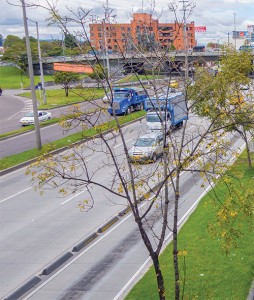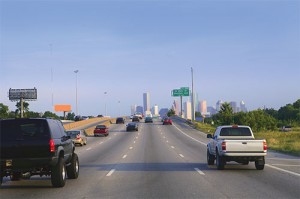 In the 3rd quarter of 2014, AT&T connected more new vehicles than new smartphones for the first time. Growing to reach a 40% share, automaker and aftermarket telematics will be the dominant sector for cellular M2M connections, according to ABI Research. The next frontier to create a differentiating connected vehicle experience is to connect our vehicles to our homes, our smart grids and most importantly a smart roadside infrastructure to deliver on the promise of safer, smoother and more enjoyable rides on our roads.
In the 3rd quarter of 2014, AT&T connected more new vehicles than new smartphones for the first time. Growing to reach a 40% share, automaker and aftermarket telematics will be the dominant sector for cellular M2M connections, according to ABI Research. The next frontier to create a differentiating connected vehicle experience is to connect our vehicles to our homes, our smart grids and most importantly a smart roadside infrastructure to deliver on the promise of safer, smoother and more enjoyable rides on our roads.
But smart connected roads appear to be utopia faced with a reality where current road funding is failing to even maintain our roads, and where bad roads are imposing a hidden tax on our economy, and as a result leaving underfunded governments to hold the lifeline for transportation innovation.
It is upon us again here in the Midwest. Our roads are facing the grueling cycle of freezing and melting that will strip away the band aids and rip open hardly healed scars from last winter and force us motorists to steer clear of minefields of treacherous potholes.
In 2014, my “tax” for driving on substandard roads was two new suspensions, new steering seals and a set of new tires. Each vehicle owner in the US pays this nearly $400 dollar “bad road tax” each year, totaling $80 billion according to a study by TRIP.
The “bad road tax” nearly doubles the roughly $100 Billion in fuel tax and tolls the US collects and spends each year to maintain our road infrastructure. $100 Billion translates into a 0.4% return on our paved road assets of estimated $27 trillion in value and means that we are “sweating” our road transportation infrastructure for 250 years.
Two to three times the available annual budget is needed to improve conditions, but the increasing cost of road improvement and the eroding motor fuel tax base further exacerbate the crippling budget shortfall. That is why more than 25% of US roads and bridges are in significant need of repair and cause $80 billion damage to our vehicles each year and why we are wasting over 100 hours in congested traffic each year, a cost of another $120 Billion.
We need new funding sources to fix our roads and to connect them for a future where intelligent transportation systems will be run with networked information. While there is broad consensus on these worthy goals, suggestions on how to get there are often met by countless concerns of the guardians of the status quo. Let me share some food for thought from many discussions with government and industry stakeholders, some admittedly off the beaten path.
 Nobody wants tolls or another stupid tax? Maybe, but every one of us indirectly pays more than $7,000 per vehicle per year in “hidden societal taxes” for bad roads, for crashes and for the time we lose stuck in traffic. A Smart Road Price would make these hidden costs visible, be a tool to reduce them and spawn innovations that benefit all of us. In contrast to conventional mileage based tolls, a Smart Road Price charges for driving on roads – based on time of day, road congestion, road type and condition, allowable speed, vehicle weight, fuel economy, or emissions – thus provides smart incentives for drivers and road operators to balance supply and demand more effectively. Overly stressed parts of the road system would dynamically command price premiums to flexibly divert demand to less costly routes and,eventually, to finance the elimination of bottlenecks. Drivers could invest in the roads most traveled and most important for their personal commutes, which would yield returns in both time and money for them.
Nobody wants tolls or another stupid tax? Maybe, but every one of us indirectly pays more than $7,000 per vehicle per year in “hidden societal taxes” for bad roads, for crashes and for the time we lose stuck in traffic. A Smart Road Price would make these hidden costs visible, be a tool to reduce them and spawn innovations that benefit all of us. In contrast to conventional mileage based tolls, a Smart Road Price charges for driving on roads – based on time of day, road congestion, road type and condition, allowable speed, vehicle weight, fuel economy, or emissions – thus provides smart incentives for drivers and road operators to balance supply and demand more effectively. Overly stressed parts of the road system would dynamically command price premiums to flexibly divert demand to less costly routes and,eventually, to finance the elimination of bottlenecks. Drivers could invest in the roads most traveled and most important for their personal commutes, which would yield returns in both time and money for them.
The standard Smart Road Price could be set at the average fuel tax a vehicle owner pays per mile. In addition, participation could be made optional. This way, drivers could elect to pay a Smart Road Price in exchange for no longer having to pay fuel tax. Increasing the fuel tax over time towards a planned long-term phase out could provide further incentive to join Smart Road Pricing immediately.
U.S. toll projects have not been overly successful? Approximately 34 percent of the highway system across Europe is toll-operated, compared to 3 percent of the national highway system in the United States. If a no-cost road alternative is readily available, many drivers will opt for the no-cost alternative, undermining the very business foundation of toll operated roads. One way to address this issue is to implement a ubiquitous Smart Road Pricing system that covers the entire road system, as it is being discussed in Germany and other European countries. However, a Smart Road Price system would require ubiquitous vehicle connectivity platform that would replace incumbent technologies like proprietary toll collection systems, road gantries, license plate recognition, and certainly “vignettes”.
Who pays for the on-board connectivity unit? Most new vehicles produced in the US will be equipped with embedded connectivity. Connected vehicle life cycle and owner management, navigation and infotainment, and most importantly safety – 80% of crash scenarios can be addressed with vehicle connectivity – are making a compelling case forvehicle connectivity. An App that collects a smart road price would add another reason to justify this investment. Waiving vehicle-licensing fees for one or more years to subsidize the on-board unit could further accelerate the penetration in both, the new vehicle and more importantly the vehicle aftermarket.
Who pays for the connected roadside infrastructure? Connecting vehicles to roadside infrastructure in the United States could be a profitable business at a cost of only a tenth of a cent per vehicle mile traveled, or one dollar per vehicle per year. While US Department of Transportation (DOT) cost estimates for connecting vehicles to infrastructure have varied over time, an estimate we used indicated that $2.3 billion in revenues is needed to fund a roadside infrastructure business with 50% gross margin.
Who should lead this – government or industry? A city, county, state or the federal government could transfer its road assets – or parts of them – into Connected Road Investment Trusts, in return for partial cash out or as an investment, if public asset ownership is preferred. The Connected Road Investment Trusts could attract additional private investments in the financial market or from stakeholders like road builders, intelligent transportation system providers or mobile network operators. The funds raised could be invested in an Intelligent Transportation Services New Co that collects a Smart Road Price for the use of these roads.
In due time, Smart Road Price revenue could be deployed to fix our roads and to build an intelligent transportation system that connects vehicles to traffic operations, traffic lights, streetlights, electronic signs, road sensors, parking spots, and provides ubiquitous roadside internet access. Intelligent

Andreas Mai is Director, Smart Connected Vehicles, Cisco Systems, Inc
Transportation Services could be sold to drivers to reduce the risk of crashes and congestion and to infrastructure operators to improve planning and maintenance of roads.
This would help reduce the nearly $400 dollar cost each vehicle owner pays for driving on our substandard roads, and help unlock benefits of more than $1,400 per connected vehicle per year.
The Connected Road Investment Trust would also accelerate the growth of the connected vehicle and intelligent transportation system industries and become an engine for job creation. Based on earlier estimates, selecting the top 20 percent of the nearly 1 million miles of the US national highway system with highest congestion, crash risk or repair needs, and assuming a Smart Road Price participation of 1/3 of US drivers has the potential to create between 400,000 and 550,000 jobs.
However, making this idea real would require a big leap of faith in any land of [the] free roads. Therefore, other nations with even more pressing transportation problems or more appetite for making connected transportation an economic growth engine, may end up winning this global innovation race.
 TrafficInfraTech Magazine Linking People Places & Progress
TrafficInfraTech Magazine Linking People Places & Progress